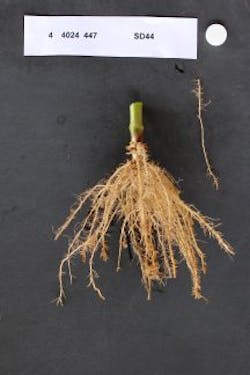Imaging system evaluates root systems of plants to improve crops
Researchers from the Georgia Institute of Technology and Penn State University have developed a technique that utilizes digital cameras and image analysis software to measure and analyze the root systems of plants.
MORE ARTICLES
VISION 2014: See the latest machine vision cameras and solutions
Scientists are working to improve food crops to meet the needs of a growing population, but boosting crop output requires improving more than what can be seen of the plants above the ground. These scientists need to understand more about what is happening in the root systems of these plants. To address this need, the researchers developed an imaging system that uses off the shelf digital cameras and analysis software that enables the evaluation of root systems in plants in field conditions.
The cameras used in the research included a Nikon D70 and Canon Powershot A1200, as well as an iPhone. Individual plants were dug up in the field and the root systems were washed clean of soil, and the scientists captured images of the root systems with these cameras against a black background. The images are then uploaded to a server running software that analyzes the root systems for more than 30 different parameters, including the diameter of tap roots, root density, the angles of brace roots, and detailed measures of lateral roots. Scientists working in the field can upload their images at the end of a day and have spreadsheets of results ready for study the next day, according to a press release.
"We’ve produced an imaging system to evaluate the root systems of plants in field conditions," said Alexander Bucksch, a postdoctoral fellow in the Georgia Tech School of Biology and School of Interactive Computing. "We can measure entire root systems for thousands of plants to give geneticists the information they need to search for genes with the best characteristics."
Bucksch added, "In the lab, you are just seeing part of the process of root growth. We went out to the field to see the plants under realistic growing conditions."
Data and information generated by this research will be used in subsequent analysis to help understand how changes in genetics affect plant growth, with the overall goal being to develop improved plants that can feed increasing numbers of people and provide sustainable sources of energy and materials. The research, which was published in the October issue of Plant Physiology, is supported by the National Science Foundation’s Plant Genome Research Program (PGRP) and Basic Research to Enable Agriculture Development (BREAD), the Howard Buffett Foundation, the Burroughs Wellcome Fund and the Center for Data Analytics at Georgia Tech.
View the research paper.
Share your vision-related news by contacting James Carroll, Senior Web Editor, Vision Systems Design
To receive news like this in your inbox, click here.
Join our LinkedIn group | Like us on Facebook | Follow us on Twitter | Check us out on Google +
About the Author

James Carroll
Former VSD Editor James Carroll joined the team 2013. Carroll covered machine vision and imaging from numerous angles, including application stories, industry news, market updates, and new products. In addition to writing and editing articles, Carroll managed the Innovators Awards program and webcasts.
